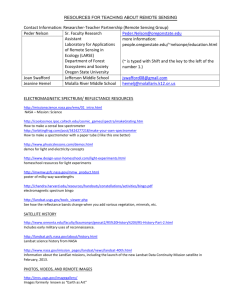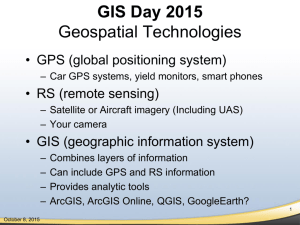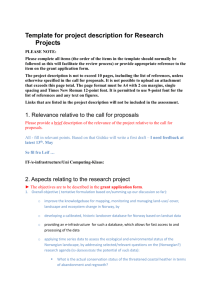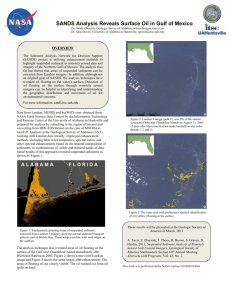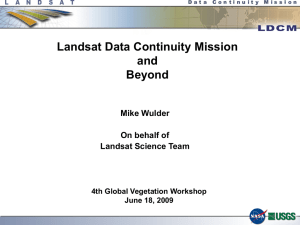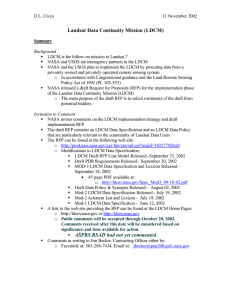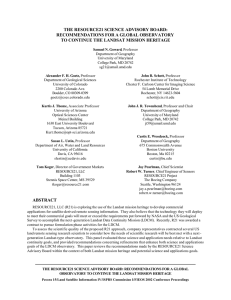Why Landsat 83B3
advertisement
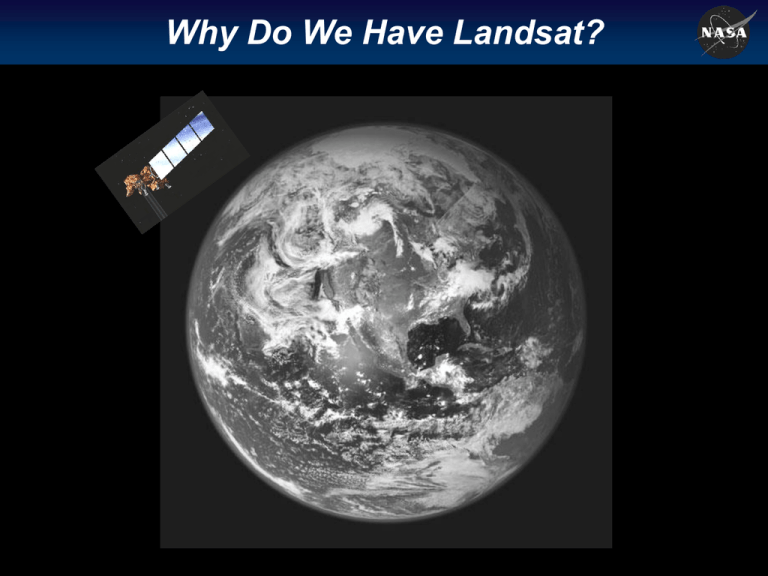
Why Do We Have Landsat? NASA’s Earth Science Research Questions •How is the global Earth system changing? •What are the primary causes of change in the Earth System? •How does the Earth system respond to natural and humaninduced changes? •What are the consequences of change in the Earth systems for human civilization? •How can we predict future changes in the Earth system? Page 2 Landsat Science Themes Together with other Earth Observing Satellite instruments, Landsat plays a critical role in NASA’s studies of Earth. A cornerstone of NASA’s Global Change Research: Monitoring Ecosystem Changes • Climate Dynamics • Quantifying Water and Energy Budgets • Quantifying Earth’s Carbon Cycle Page 3 Monitoring Ecosystem Changes NASA Earth Science Questions with Respect to Ecosystems: •How are global ecosystems changing? •How do ecosystems respond to and affect global environmental change and the carbon cycle? Although Climate Change is a global phenomenon… … the effects of climate change on ecosystems are local and heterogeneous - treeline/ecotone changes - invasive species - desertification - coral reef declines, etc. Page 4 Monitoring Ecosystem Changes Forest fragmentation in Amazon basin Mapping Spotted Owl Habitat, Oregon Coastal Marsh Loss in the Eastern U.S. Loss of Mesopotamian Wetlands Mapping extent and morphology of coral reefs Page 5 Monitoring Ecosystem Changes Gradual changes require long-term, repeat satellite coverage Landsat data are used to: •Precisely assess the area affected •Separate human from natural causes •Bridge the gap between field observations and global monitoring Loss of wetlands in Mesopotamia (dark red areas) since 1973 from Landsat. Courtesy Hassan Partow, UNEP 1973-76 2000 Page 6 Monitoring Ecosystem Changes Ecosystem disturbance and invasive species may be harbingers of climate change Example: Eastern Hemlock Decline Ridge & Valley Highlands Piedmont D. Royle and R. Lathrop, Rutgers University Page 7 Monitoring Ecosystem Changes • Landsat is well suited to providing detailed maps bands of burned areas A ratio of Landsat 4 and 7 is also and for verification of coarse scale burn-scar usedoperational to create burn severity maps which mapping. are key in the post-fire rapid assessment process led by the Burn Area Emergency Response (BAER) Team. April 14, 2000 Before Fire Cerro Grande Fire, New Mexico May 9, 2000 During Fire June 17, 2000 After Fire Courtesy U.S. Forest Service Page 8 • Monitoring Ecosystem Changes • Climate Dynamics • Quantifying Water and Energy Budgets • Quantifying Earth’s Carbon Cycle Page 9 Landsat and Climate Modeling MODIS, AVHRR SeaWiFS Landsat Regional Land-cover and surface properties Global Surface Properties Global Climate Models Regional Climate Analyses Mesoscale Models Global Climate and Weather Page 10 Example: Climate and Land-Cover Change Do changes in landscape structure affect regional climate? QuickTime™ and a TIFF (Uncompressed) decompressor are needed to see this picture. Pre-1900 Vegetation 1990’s Land Cover from Landsat Page 11 •Monitoring Ecosystem Changes • Climate Dynamics • Quantifying Water and Energy Budgets • Quantifying Earth’s Carbon Cycle Page 12 Quantifying Water and Energy Budgets Will future water supplies meet human needs? ARAL SEA 1973 • By 2025, 48% of global population will live in “water stressed” basins (<1700 m3/pers/yr) 1987 2000 Courtesy WRI Water flux into the Aral Sea is being diverted for human use Page 13 Quantifying Water and Energy Budgets What changes are occurring in the mass of the Earth's ice cover? Mountain Glacier Dynamics Franz Josef Glacier, New Zealand Most mountain glaciers worldwide have been retreating Pasterze Glacier, Austria 06-Sept-1999 D. Hall, NASA GSFC Page 14 Quantifying Water and Energy Budgets Antarctic Monitoring Landsat Archive R. Bindschadler, NASA GSFC Page 15 LDCM Science Themes Together with other Earth Observing Satellite instruments, Landsat plays a critical role in NASA’s studies of Earth: • Monitoring Ecosystem Changes • Climate Dynamics • Quantifying Water and Energy Budgets • Quantifying Earth’s Carbon Cycle Page 16 Quantifying Earth’s Carbon Cycle Increasing atmospheric CO2 levels are correlated with increasing global temperatures “How well can cycling of carbon through the earth system be modeled, and how reliable are predictions of future atmospheric concentrations of carbon dioxide and methane by these models?” 375 Atmospheric CO2 ppm 350 325 300 275 250 1000 1200 1400 1600 1800 2000 year( AD) Page 17 6 Emissions from Fossil Fuels Net release from land-use change Pg C / yr Unidentified sink 4 2 0 Oceanic uptake Atmospheric accumulation 5.5 +/- 0.5 Reforestation Fire Supression 1.6 +/- 1.0 Woody Encroachment 1.9 -2 2.0 +/- 0.8 -4 3.2 +/- 0.2 Sinks 8 Source Carbon Sources and Sinks CO2, N Fertilization Climate -6 -8 1850 1870 1890 1910 1930 1950 1970 1990 Human-induced Carbon Flux since 1850: where has all the carbon gone? source: WHRC Page 18 The Landsat Mission •Over 30-year years of global land cover data •Resolution shows human activities •Key information for climate, ecosystems, biogeochemical cycles, and hydrology studies EPA-USGS NALC Land-cover Dataset Page 19 Landsat – 30 Years of Earth Observations Landsat-1 (ERTS) Landsat-2 Landsat-3 Landsat-4 Landsat-5 Landsat-6 MSS (79 m, 4 band) Landsat-7 TM (30/120 m, 7 band) ETM+ (15/30/60 m, 8 band) LDCM Sensor (15/30/90 m, 9 band 1970 1980 LDCM 1990 2000 2010 Commercial operations Government operations Page 20 Landsat-7 Global Acquisitions The first truly global archive Page 21 Landsat Data Continuity Mission Extending the Legacy of Global Land Observations The Landsat Data Continuity Mission (aka LDCM) will continue the legacy of the Landsat program. Launch dates are years away, and the request for proposals for the instrument is to be released soon. For more information on the next satellite in the Landsat series, please visit http://ldcm.gsfc.nasa.gov Page 22 National Aeronautics and Space Administration http://www.nasa.gov Page 23
